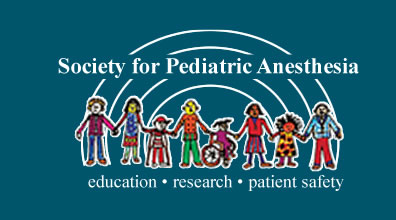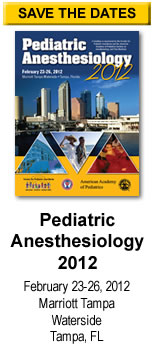CCAS Meeting Reviews
CCAS Morning Session
 Submitted By Robert D. Valley, MD
Submitted By Robert D. Valley, MD
University of North Carolina
The Congenital Cardiac Anesthesia Society (CCAS) meeting was held on March 31, 2011 in San Diego California. This was the fifth anniversary of the society. Dr. James Dinardo (Children’s Hospital Boston) opened the meeting and gave an outline of the day’s activities.
Dr. Chandra Ramamoorthy (Stanford University Medical Center) was the moderator for the first group of morning presentations that was titled “Living with Hypoxia." The first presentation in this session, “Surviving Chronic Hypoxia: Do we have the necessary genes?” was by Dr. Mike Crowder (Washington University, St Louis, MO). He reviewed some of the human data supporting the theory of hypoxic preconditioning and gave an extensive review of laboratory research into mechanisms for hypoxic preconditioning, including the possible role of hypoxia-induced misfolded proteins as induction agents for preconditioning.
The second presentation in this session, “Ischemic Preconditioning: An interesting concept or a clinical reality," was by Dr. Christopher Caldarone (University of Toronto, Hospital for Sick Children). He gave a very interesting review of the evolution of preconditioning concepts. The “preconditioning stimulus” can actually occur before, during or after the ischemic event. Even more interesting is evidence that “remote ischemia” may be protective to other parts of the body subjected to ischemia and that bloodborne effectors may be released that have multi-organ protective effects.
The third speaker of this session was Dr. Scott Walker (Riley Children’s Hospital). His excellent talk, “Anesthetic Management of a Child with Long Standing Hypoxia” used an actual patient with uncorrected TGV as a starting point to review many of the physiologic responses to hypoxia, the limitations of our current monitors in patients with cyanotic congenital heart disease and the dangers of hyperviscosity syndrome.
The second morning session, “Cardiac MRI: Sexy Pictures or Useful Information” was moderated by Dr. Helen Holtby (Hospital for Sick Children, Toronto). The first speaker in this session was Dr. David Parra (Children’s Hospital at Vanderbilt). His talk was titled, “Cardiovascular MRI, Why pediatric cardiologists want it." He provided an excellent introduction to the uses of cardiac MRI to investigate anatomy, ventricular function, blood flow quantification (e.g. Qp/Qs, regurgitant fraction) and tissue characterization. He concluded by reviewing current indications for cardiac MRI in patients with congenital heart disease.
Dr. Kirsten Odegard (Children’s Hospital Boston) gave the second lecture of this session, “Challenges of Anesthetizing for Cardiac MRI." She discussed the usual problems encountered with providing anesthesia care in the MRI environment, coupled with some of the sickest patients. She reviewed the experience at Boston Children’s with cardiac MRI. The high-risk nature of the patients, the need for breath holding to improve image quality and the long duration (1 to 2 hr) of the scans were sited as reasons to recommend general anesthesia for the majority of these patients.
The final morning session was moderated by Dr. Suanne Daves (Vanderbilt University Medical Center). This session was called “Sickest of the Sick” and included three brief case presentations of some of the scariest children with congenital heart disease that we are asked to anesthetize.
The first case report, “Three month Old with Dilated Cardiomyopathy for Evaluation for Heart Transplantation” was presented by Dr. Emad Mossad (Texas Children’s Hospital). This was followed by an excellent review of dilated cardiomyopathy in children, the Texas Children’s experience and recommendations for anesthetic management.
The second case report was presented by Dr. Alexander Hughes (Vanderbilt University Medical Center). His case report was titled, “Williams Syndrome with Critical AS and PS for Cardiac Cath and Potential Balloon Dilation." He provided a very nice overview of this genetic disorder and emphasized the risk for sudden death and ischemia with anesthesia. He noted that these untoward events can occur not only during the anesthetic but also during recovery, and pointed out the need to carefully plan for both intraoperative and postoperative care.
The final case report, “Three Month Old with BT Shunt Brought to the Cath Lab with Severe, Persistent Desaturation” was presented by Dr. Nina Guzzetta (Emory Healthcare System). Dr. Guzzetta reviewed “BT shunt physiology," the causes of shunt thrombosis and the important need to differentiate between acute and chronic (gradual) increases in cyanosis. In addition to shunt thrombosis, the other causes for decreases in systemic oxygenation need to be considered. A skilled anesthesiologist familiar with caring for critically ill children with complex cyanotic heart disease is an essential part of the health care team for these children.
CCAS Afternoon Session
 Submitted by Christopher J. Stemland, MD
Submitted by Christopher J. Stemland, MD
University of Virginia
Dr. John Meliones (Duke University Medical Center) presented an informative lecture describing the alterations in pulmonary compliance encountered after cardiopulmonary bypass. Diminished pulmonary compliance after bypass results from hemodilution with fluid accumulation, surfactant inactivation, and the release of cytokines and inflammatory mediators. Alveolar overdistension and volutrauma increase days of mechanical ventilation, morbidity, and hospital expenditures. Careful examination of lung volume compliance curves allows for distinction between pulmonary overdistension and the need for continued alveolar recruitment. Construction of these compliance curves provides more useful information than graphically displayed loops on the ventilator.
Dr. Alexander Mittnacht (Mount Sinai, NY) advocates for early extubation after both simple and complex pediatric cardiac surgery. He cites decreased ventilator days, improved pulmonary and systemic hemodynamics, and a reduction in ICU days and cost as benefits for early extubation. Spontaneous ventilation and permissive hypercapnia after bidirectional Glenn or Fontan improves both cerebral and systemic perfusion without significantly elevating pulmonary vascular resistance. By lowering SVR, early extubation improves cardiac index while minimizing atelectasis and pneumonia after cardiac surgery. On the other hand, Dr. Frank McGowan (USC, Charleston, SC) presented a rather cogent argument cautioning against early extubation after pediatric cardiac surgery. Cardiopulmonary bypass creates accumulation of lung water, alveolar edema, and decreased pulmonary compliance. Moreover, just because “we get away with early extubation doesn’t necessarily mean we should do it.”
Pediatric cardiologist Dr. Angela Sharkey (WashU, St. Louis) reviewed the surgical pathology of Tetralogy of Fallot and succinctly stated that TOF is “the most common form of cyanotic congenital heart disease, an anatomic malformation resulting from anterior deviation of the infundibular septum with resultant underdevelopment of the structures of the right ventricular outflow tract, including the main and branch pulmonary arteries as well as the pulmonary valve." The subarterial malalignment VSD creates the classic aortic override seen in Tetralogy of Fallot. The right ventricular outflow tract obstruction may be subvalvular, valvular, or supravalvular in relation to the pulmonic valve.
Pediatric cardiac surgeon Dr. John Lamberti (Rady Children’s Hospital, San Diego) discussed the numerous variants of Tetralogy of Fallot and how surgical approaches are determined by experience level. He highlighted low mortality rates from his institution that approach a mere 1.9% after including complex operations. He summarized by underscoring the importance of teamwork amongst diverse providers in the care of children with congenital heart disease.
Dr. Wanda C. Miller-Hance (Texas Children’s Hospital) lectured on the TEE evaluation of Tetralogy of Fallot and Double Outlet Right Ventricle (DORV). Transesophageal echocardiography provides essential information for the initial assessment and subsequent evaluation in Tetralogy of Fallot. Dr. Miller-Hance “echoed” comments by Dr. Sharkey by stating that “although it is well recognized that TOF represents a spectrum of disease, and in fact specific types of DORV may be considered by some to be part of this spectrum, in TOF the anatomic anomalies are all the result of a basic malformation, namely an underdeveloped pulmonary infundibulum.”


 Click
Click 